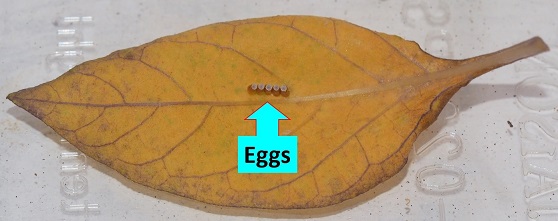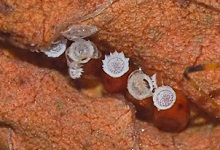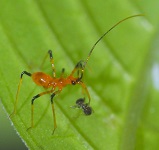| Home | Nature Weekly Index |
28 June 2020 | Eggs of Yellow Assassin Bug | Cosmolestes picticeps |
On the morning of 14 June, I saw a Yellow Assassin Bug (Cosmolestes picticeps) on the underside of a leaf of the Black Nightshade (Solanum americanum) located outside my balcony. This potted Black Nightshade had grown to such a large size that most of its leafy part was hanging in the air outside the balcony. It was from a distance of my balcony that I saw the bug. Since it was such a common bug, it did not motivate me to pick up my camera.
 That afternoon, while I was surveying my balcony’s vegetated area to find interesting photographing targets, the
bug had disappeared. When I looked at the leaf that the bug was standing in the morning, a tiny spot of orange
coloured object caught my attention. I stretched my hand out of the balcony to pull the branch closer to examine
it and take some pictures. After examining the enlarge view of the pictures, the material turned out to be a row
of 5 bottle-like insect eggs lining side by side adjacent to each other. I sensed that they belonged to the
Yellow Assassin Bug. This was indeed an exciting discovery.
That afternoon, while I was surveying my balcony’s vegetated area to find interesting photographing targets, the
bug had disappeared. When I looked at the leaf that the bug was standing in the morning, a tiny spot of orange
coloured object caught my attention. I stretched my hand out of the balcony to pull the branch closer to examine
it and take some pictures. After examining the enlarge view of the pictures, the material turned out to be a row
of 5 bottle-like insect eggs lining side by side adjacent to each other. I sensed that they belonged to the
Yellow Assassin Bug. This was indeed an exciting discovery.
I eagerly search for assassin bug eggs online but could only find one picture that looked similar. However, the name of the bug was not mentioned. Yellow Assassin Bug is a common assassin bug found in Singapore and elsewhere as evident from the amount of images posted online. I always chanced upon them in the park next to my home. To prove this point, I decided to look for them at the park over the last 2 Sundays. I had not been to this park for a few months now due to the COVID-19 situation. During the 2 walks, I counted 2 adults and 2 nymphs.


 Four days gone by with no sign of the eggs hatching. The leaf where the eggs attached had turned yellow and was
expected to drop off soon. To salvage the eggs, I collected the yellow leaf and placed it in a closed
transparent container. On day 8, the whitish lid at the top of 2 eggs showed visible sign of breakage and 2
nymphs were found in the container. Finally, the last 3 nymphs emerged on the next day. To make sure that the
baby bugs had food, I placed a few leaves that had
whiteflies and their eggs on them into the
container. However, I did not observe the nymphs feeding on them. On day 10, I released all 5 nymphs back on
the Black Nightshade for them to find their own food since they did not like what I served. Two days later, I
could only locate one nymph. It had caught a small ant!
Four days gone by with no sign of the eggs hatching. The leaf where the eggs attached had turned yellow and was
expected to drop off soon. To salvage the eggs, I collected the yellow leaf and placed it in a closed
transparent container. On day 8, the whitish lid at the top of 2 eggs showed visible sign of breakage and 2
nymphs were found in the container. Finally, the last 3 nymphs emerged on the next day. To make sure that the
baby bugs had food, I placed a few leaves that had
whiteflies and their eggs on them into the
container. However, I did not observe the nymphs feeding on them. On day 10, I released all 5 nymphs back on
the Black Nightshade for them to find their own food since they did not like what I served. Two days later, I
could only locate one nymph. It had caught a small ant!
If the nymphs feed on whiteflies, they would have landed on the right place. Whiteflies loved the leaves of Black Nightshade and there were plenty of them on the underside of the leaves right now. I recalled the sighting of 2 nymphs of this assassin bug in July 2013 on my Cherry Tree (Muntingia calabura) planted along the balcony area. The Cherry Tree was removed few years back. More recently, I noticed that the whiteflies also attacked the leaves of the Cherry Tree. The sticky surface of the Cherry Tree leaves was a trop for many types of tiny insects except for the whiteflies. That might explain the appearance of the nymphs of the assassin bugs on the tree previously.